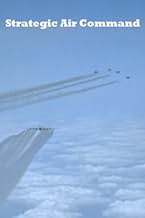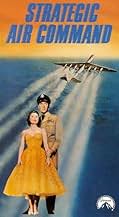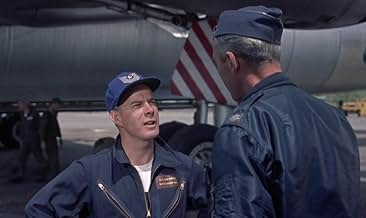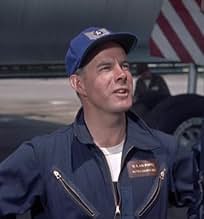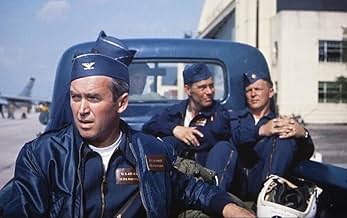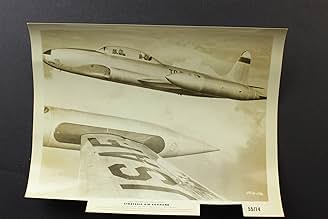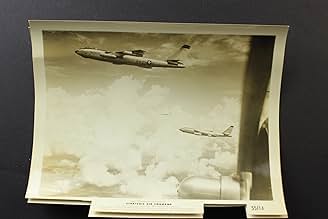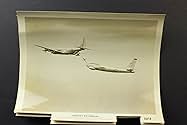VALUTAZIONE IMDb
6,3/10
4314
LA TUA VALUTAZIONE
Aggiungi una trama nella tua linguaAn ex-pilot and current baseballer is recalled into the U.S. Air Force and assumes an increasingly important role in Cold War deterrence.An ex-pilot and current baseballer is recalled into the U.S. Air Force and assumes an increasingly important role in Cold War deterrence.An ex-pilot and current baseballer is recalled into the U.S. Air Force and assumes an increasingly important role in Cold War deterrence.
- Regia
- Sceneggiatura
- Star
- Candidato a 1 Oscar
- 1 vittoria e 2 candidature totali
Rosemary DeCamp
- Mrs. Thorne
- (as Rosemary De Camp)
John McKee
- Capt. Symington
- (as John R. McKee)
Harry Morgan
- Sgt. Bible - Flight Engineer
- (as Henry Morgan)
Mary Ellen Batten
- Woman in Cafe
- (non citato nei titoli originali)
Helen Brown
- Nurse
- (non citato nei titoli originali)
Glen Denning
- Sgt. Jones - Radio Operator
- (non citato nei titoli originali)
Bess Flowers
- Party Guest
- (non citato nei titoli originali)
Don Haggerty
- Major - Patrol Commander
- (non citato nei titoli originali)
Recensioni in evidenza
68/100. Not one of Jimmy Stewart's best films, but not fault of his. He is terrific. June Allyson, I don't know what exactly it is I don't like about her. I feel her performances are so rehearsed and phony. She is way too sappy and understanding in this film and I feel she hurts the films overall effect. Some excellent aerial photography, good score and the entire production is top notch. It waves the flag a little excessively and the mix of personal drama and action sequences is at times a little awkward. The supporting cast is a bit bland, Harry Morgan and Rosemary deCamp stand out as the best. Good special effects. The color in the film was exceptionally crisp.
James Stewart flew more than 26 combat missions in WWII as the commander of a B-24. The infamous Ploesti oil field raids were the most dangerous of the war, and he flew a B-24 50ft off the deck on several runs.
This was a great man, and a fine, fine actor. His commitment to the U.S. Air Force SAC command resonated in this film. His courage in WWII and the courage and sacrifice of that entire WWII generation has been forgotten in what is left of America---the remaining oldsters of that generation, and their baby-boomer offspring who did not sandblast their brains with pot and booze back in the 60s and 70s being the only group that would enjoy this film and remember what it was all like back then. The rest of the "citizens' of this country register nothing when WWI or II is talked about. They do not even remember the Cold War and the hammer of nukes we all lived under, and still are threatened by.
The massive 10-engined (6 props, 4 jets) B-36 was the iconic cornerstone of 50s bomber tech. A magnificent leviathan that could fly for days at very high altitudes, and carry massive amounts of dumb bombs, or, in one aircraft, enough H-bombs to end the world. Google the B-36 and gaze upon an almost surrealistic machine that broke plates, glasses and windows when it flew over with a basso profundo propeller sound unlike anything ever heard before or since.
I remember my father pointing them out, very high in the sky, white contrails feathering back for miles behind them....and that roar.....distant and discordant...you could hear a B-36 fly over even at 40,000 feet.
"Strategic Air Command" was an extended showpiece for that airplane, and a beautiful piece of music, "Symphony of Flight" carries the film into the in-flight scenes that make the movie so transcending of an admittedly formulaic human drama. It is an amazing historical piece that actually shows the transition from props to full jets that the Air Force went through in the 50s. At the end, there is pristine footage of the B-47, the first U.S. jet bomber, and Stewart has an adventure with that.
The cockpit shots of the B-36 and B-47 probably drove Russian spies to a frenzy, but for an aviation buff they were the stuff of dreams.
The crash landing of Stewart's B-36 was done in miniature format, and actually was a weak point of the film. The model was too small to make the crash look realistic---Howard and Theodore Lydecker could have knocked that scene out of the park.....the bad weather landing of the B-47 at the end of the film was also done in miniature, and looked better, reminding me of how much fun special effects must have been in the pre-CGI days.
For an intimate look at a huge Cold warrior, and some beautiful music, plus a look at June Allyson's legs that could make the whole movie for you, I highly recommend "Strategic Air Command"
This was a great man, and a fine, fine actor. His commitment to the U.S. Air Force SAC command resonated in this film. His courage in WWII and the courage and sacrifice of that entire WWII generation has been forgotten in what is left of America---the remaining oldsters of that generation, and their baby-boomer offspring who did not sandblast their brains with pot and booze back in the 60s and 70s being the only group that would enjoy this film and remember what it was all like back then. The rest of the "citizens' of this country register nothing when WWI or II is talked about. They do not even remember the Cold War and the hammer of nukes we all lived under, and still are threatened by.
The massive 10-engined (6 props, 4 jets) B-36 was the iconic cornerstone of 50s bomber tech. A magnificent leviathan that could fly for days at very high altitudes, and carry massive amounts of dumb bombs, or, in one aircraft, enough H-bombs to end the world. Google the B-36 and gaze upon an almost surrealistic machine that broke plates, glasses and windows when it flew over with a basso profundo propeller sound unlike anything ever heard before or since.
I remember my father pointing them out, very high in the sky, white contrails feathering back for miles behind them....and that roar.....distant and discordant...you could hear a B-36 fly over even at 40,000 feet.
"Strategic Air Command" was an extended showpiece for that airplane, and a beautiful piece of music, "Symphony of Flight" carries the film into the in-flight scenes that make the movie so transcending of an admittedly formulaic human drama. It is an amazing historical piece that actually shows the transition from props to full jets that the Air Force went through in the 50s. At the end, there is pristine footage of the B-47, the first U.S. jet bomber, and Stewart has an adventure with that.
The cockpit shots of the B-36 and B-47 probably drove Russian spies to a frenzy, but for an aviation buff they were the stuff of dreams.
The crash landing of Stewart's B-36 was done in miniature format, and actually was a weak point of the film. The model was too small to make the crash look realistic---Howard and Theodore Lydecker could have knocked that scene out of the park.....the bad weather landing of the B-47 at the end of the film was also done in miniature, and looked better, reminding me of how much fun special effects must have been in the pre-CGI days.
For an intimate look at a huge Cold warrior, and some beautiful music, plus a look at June Allyson's legs that could make the whole movie for you, I highly recommend "Strategic Air Command"
Next year, 2005, will be the 50th anniversary of the movie, "Strategic Air Command." Nearly all reviews of this movie are quite similar...a somewhat boring movie with unsurpassed aerial photography of the magnificent B-36. (One really needs to see the in-flight sequences...they are extraordinary!)
These valid comments really ignore the "larger picture." The B-36 (Peacemaker) stopped flying before the average person living today was born...it was a long time ago. This movie captures a time in America when the military...SAC with its aircraft...ADC (Air Defense Command) with its hundreds of radar sites nationwide...civilians in The Ground Observer Corps...were all involved in "watching the sky" in order to help protect and defend from possible attack by our cold war enemies.
It is difficult, understandably, for many today to comprehend the times and attitudes depicted in "Strategic Air Command." I was there...it did happen. This movie captures some of the dedication that was required. With that in mind, perhaps we can forgive a script and story line that is weak. More importantly, let's celebrate that, a half-century ago, many served and did their duty as the times required. That is the real message of this movie.
These valid comments really ignore the "larger picture." The B-36 (Peacemaker) stopped flying before the average person living today was born...it was a long time ago. This movie captures a time in America when the military...SAC with its aircraft...ADC (Air Defense Command) with its hundreds of radar sites nationwide...civilians in The Ground Observer Corps...were all involved in "watching the sky" in order to help protect and defend from possible attack by our cold war enemies.
It is difficult, understandably, for many today to comprehend the times and attitudes depicted in "Strategic Air Command." I was there...it did happen. This movie captures some of the dedication that was required. With that in mind, perhaps we can forgive a script and story line that is weak. More importantly, let's celebrate that, a half-century ago, many served and did their duty as the times required. That is the real message of this movie.
If you like old airplanes, you'll love this movie. Seeing the B-36 and B-47 from the POV of people laying eyes on them for the first time was a trip. Despite it's slightly stilted propaganda dialouge, this is a film well worth watching.
"Strategic Air Command" is a look at the 1950's, when the needs of the Cold War caused America to begin rearming after having nearly disarmed itself following World War II.
With his trademark sincerity, James Stewart plays Lt. Col. Holland, a former Air Force officer and now ballplayer who is recalled to duty as the new Strategic Air Command expands its might. June Allyson plays Sally, his devoted wife. Together they and the other families of SAC have to cope with the strains that SAC missions put on their personal lives.
The stresses that SAC duty put on families is true enough. But as movie drama it's all written in a way that's utterly trite and predictable. You can practically guess in advance the main set-pieces: Sally is going to become pregnant and have to deal with it without her husband around, Holland is going to get into some life-threatening situations and be thinking of his wife all the while, but he'll be rescued in the end, and so on.
What nearly makes up for a trite plot, however, is the spectacular aerial photography of the two "actors" that truly steal the show: SAC's B-36 Peacemaker bomber, and its state-of-the-art (at the time!) medium jet bomber, the B-47. The B-36, a huge flying battleship with six prop engines plus four jet engines, and a crew of maybe 15, is beautifully photographed in flight, with an accompanying musical score. For today's younger generation who are used to today's ultra-modern planes, the movie is worth seeing for its loving last look at a generation of impressive aircraft that never saw combat, and hence aren't as well known as both their predecessors and successors that did serve in war.
With his trademark sincerity, James Stewart plays Lt. Col. Holland, a former Air Force officer and now ballplayer who is recalled to duty as the new Strategic Air Command expands its might. June Allyson plays Sally, his devoted wife. Together they and the other families of SAC have to cope with the strains that SAC missions put on their personal lives.
The stresses that SAC duty put on families is true enough. But as movie drama it's all written in a way that's utterly trite and predictable. You can practically guess in advance the main set-pieces: Sally is going to become pregnant and have to deal with it without her husband around, Holland is going to get into some life-threatening situations and be thinking of his wife all the while, but he'll be rescued in the end, and so on.
What nearly makes up for a trite plot, however, is the spectacular aerial photography of the two "actors" that truly steal the show: SAC's B-36 Peacemaker bomber, and its state-of-the-art (at the time!) medium jet bomber, the B-47. The B-36, a huge flying battleship with six prop engines plus four jet engines, and a crew of maybe 15, is beautifully photographed in flight, with an accompanying musical score. For today's younger generation who are used to today's ultra-modern planes, the movie is worth seeing for its loving last look at a generation of impressive aircraft that never saw combat, and hence aren't as well known as both their predecessors and successors that did serve in war.
Lo sapevi?
- QuizJames Stewart joined the Army Air Corps during World War II, and flew combat missions in Europe. At war's end, he transferred to the Reserve as a colonel. He remained an active pilot in the Air Force Reserve, and was trained on the B-36 and B-47 bombers which he flew in this film. He flew one combat mission over Vietnam in a B-52. He retired as Brigadier General James Maitland Stewart, USAFR in 1968. In 1985 he was promoted on the retired list to Major General (by his friend, President Ronald Reagan), making him the highest ranking member of the military of anyone ever in the acting profession.
- BlooperAt one point, Dutch refers to his old aircraft as a B-24, not a B-29 as mentioned earlier in the film (an understandable mistake, since Jimmy Stewart commanded a B-24 Liberator during WWII, flying 29 combat missions).
- Citazioni
Sergeant: [Seeing General Hawkes speaking to the men on the flight line while smoking a cigar, whispering to Holland] Sir, that cigar. Doesn't the general know that the aircraft might explode?
Lt. Col. Robert 'Dutch' Holland: It wouldn't dare.
- ConnessioniFeatured in Entertainment This Week Salutes Paramount's 75th Anniversary (1987)
- Colonne sonoreThe Air Force Takes Command
Music by Victor Young
Lyrics by Ned Washington and Major Tommy Thomson Jr.
I più visti
Accedi per valutare e creare un elenco di titoli salvati per ottenere consigli personalizzati
- How long is Strategic Air Command?Powered by Alexa
- Midwest Premiere Happened Where & When?
Dettagli
Botteghino
- Lordo Stati Uniti e Canada
- 6.500.000 USD
- Tempo di esecuzione1 ora 52 minuti
- Mix di suoni
Contribuisci a questa pagina
Suggerisci una modifica o aggiungi i contenuti mancanti

Divario superiore
By what name was Aquile nell'infinito (1955) officially released in India in English?
Rispondi

